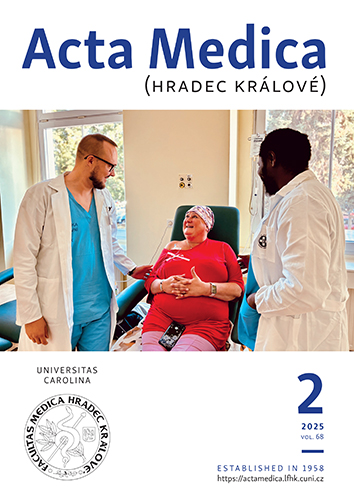ACTA MEDICA, Vol 59 No 4 (2016), 117–123
Common Mistakes in the Dual-Energy X-ray Absorptiometry (DXA) in Turkey. A Retrospective Descriptive Multicenter Study
Ali Yavuz Karahan, Bugra Kaya, Banu Kuran, Ozlem Altındag, Pelin Yildirim, Sevil Ceyhan Dogan, Aynur Basaran, Ender Salbas, Turgay Altınbilek, Tuba Guler, Sena Tolu, Zekiye Hasbek, Banu Ordahan, Ercan Kaydok, Ufuk Yucel, Selcuk Yesilyurt, Almula Demir Polat, Murat Cubukcu, Omer Nas, Umit Sarp, Ozan Yasar, Seher Kucuksarac, Gozde Turkoglu, Ahmet Karadag, Sinan Bagcacir, Kemal Erol, Emel Gurel, Serpil Tuna, Ahmet Yildirim, Savas Karpuz
DOI: https://doi.org/10.14712/18059694.2017.38
zveřejněno: 22. 02. 2017
Abstract
Background: Osteoporosis is a widespread metabolic bone disease representing a global public health problem currently affecting more than two hundred million people worldwide. The World Health Organization states that dual-energy X-ray absorptiometry (DXA) is the best densitometric technique for assessing bone mineral density (BMD). DXA provides an accurate diagnosis of osteoporosis, a good estimation of fracture risk, and is a useful tool for monitoring patients undergoing treatment. Common mistakes in BMD testing can be divided into four principal categories: 1) indication errors, 2) lack of quality control and calibration, 3) analysis and interpretation errors, and 4) inappropriate acquisition techniques. The aim of this retrospective multicenter descriptive study is to identify the common errors in the application of the DXA technique in Turkey. Methods: All DXA scans performed during the observation period were included in the study if the measurements of both, the lumbar spine and proximal femur were recorded. Forearm measurement, total body measurements, and measurements performed on children were excluded. Each examination was surveyed by 30 consultants from 20 different centers each informed and trained in the principles of and the standards for DXA scanning before the study. Results: A total of 3,212 DXA scan results from 20 different centers in 15 different Turkish cities were collected. The percentage of the discovered erroneous measurements varied from 10.5% to 65.5% in the lumbar spine and from 21.3% to 74.2% in the proximal femur. The overall error rate was found to be 31.8% (n = 1021) for the lumbar spine and 49.0% (n = 1576) for the proximal femur. Conclusion: In Turkey, DXA measurements of BMD have been in use for over 20 years, and examination processes continue to improve. There is no educational standard for operator training, and a lack of knowledge can lead to significant errors in the acquisition, analysis, and interpretation.
klíčová slova: Osteoporosis; Diagnosis; Dual Energy X-ray Absorptiometry; Technician; Education

Common Mistakes in the Dual-Energy X-ray Absorptiometry (DXA) in Turkey. A Retrospective Descriptive Multicenter Study is licensed under a Creative Commons Attribution 4.0 International License.
210 x 297 mm
vychází: 4 x ročně
cena tištěného čísla: 150 Kč
ISSN: 1211-4286
E-ISSN: 1805-9694
